Chapter 3. One Crease Origami
What is Origami?
(Origami Tanteidan Newsletter #44, #46, #48)
In this chapter, I will discuss Paul Jackson's "One Crease Origami." The pieces of one crease origami look so different from ordinary origami that some folders disapprove of them. In my opinion, however, his works are the essence of origami.
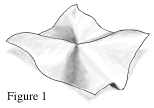
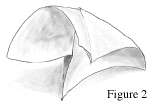
These four pictures are my sketches of Jackson's origami pieces. Figures 1 and 2 are examples of one crease origami, while figures 3 and 4 are not. Although we can easily determine that figures 3 and 4 are indeed origami pieces, some may question whether or not figures 1 and 2 can be considered origami. In this chapter, I will discuss why the pieces of one crease origami may not seem to be origami, and I will assert that they can and should be considered true pieces of origami.


Why they look different? Is this due to a lack of intricacy? The "Elephant" shown in figure 3 does look like origami in spite of the fact that it has only three creases. Besides, "one crease origami" does not mean that only one crease is allowed. Most pieces of one crease origami have one crease and some "breaks" where we add some tiny creases to create a curved surface or plane.
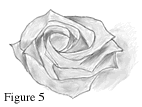
So is it these curved planes that prevent us from regarding the pieces as origami? Because we have many works of origami composed from curved planes, such as "Rose" by Kawasaki Toshikazu(figure 5), this cannot be the reason.
In my opinion, the main reason why one crease origami seems different from ordinary origami is because these pieces do not have particular titles. To be more precise, they are not models of any recognizable forms. Traditionally, it has been taken for granted that origami is equivalent to model-making. The origami elephant is a model of the real elephant, that is, the origami elephant represent the real elephant in a recognizable way.
One crease origami pieces, however, do not represent anything with a recognizable form. It does not mean they cannot have any titles. We may give them abstract titles such as "Convergent" or "Fret," but they are not models of anything concrete.
The notion of model-making has always played an important role in origami, and still does so today. But There can be origami that is not model-making.
In music, we have program music and absolute music. The works of program music have references outside of music. They represent something concrete. For example, Richard Strauss' "A Hero's Life" represents a hero's, or Strauss' own, life. On the other hand, examples of absolute music have titles such as "Symphony no.2", and are composed without concrete references.
If we apply the same idea to origami, we can say model-making origami is program origami and non model-making origami is absolute origami. Although most origami is program origami, we can find some absolute origami that most people regard as true origami. Uchiyama Koko's works of "Kamon-ori" (flower pattern folding) (figure 6) and Fuse Tomoko's works of boxes(figure 7) and spirals are excellent examples.

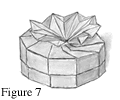
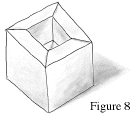
Although there are origami boxes which represent real boxes, such as David Brill's "Masu" (figure 8,) an origami box is not necessarily a model of a real box, but it can be just a box. It can be constructed with respect to its form and beauty, and not have references outside of origami. So we can say that one crease origami can be origami even if it is not model-making. In other words, model-making is not a necessary condition of origami.
Then what are the conditions of origami? Many will agree that paper cranes are origami and that newspapers, which are in fact folded sheets of paper, are not. It is not acceptable to say that origami is folding paper because such a statement does not distinguish between newspapers and paper cranes.
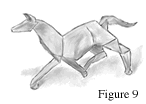
Some folders, those we call purists, put forward the precept "from one sheet of square paper without cutting." But nor is it acceptable because, though it can distinguish paper cranes from newspapers, it will exclude many excellent origami works. For instance, Brill's "Horse" (figure 9) is folded from an equilateral triangle sheet of paper. Also, works of modular origami, which are now receiving considerable popularity among folders, are folded from multiple sheets.
And we have explained, with the box example above, why the notion of model-making is an irrelevant condition of origami.
In order to find the conditions of origami, we need to think about what we do when we make origami. When we make origami, we use square, triangular, or pentagonal paper. Recently, pre-cut paper has become acceptable, but traditionally the paper has had to be cut into the desired starting shape as the first step. Next, we fold the sheets of paper. Naturally, this step is the crucial part of origami. Finally, we may use glue to keep layers from unfolding. In other words, we cut, fold, and paste the paper to make origami.
But this description is also insufficient. Looking at ordinary sealed envelopes, we see that the paper was cut, folded, and pasted. However, we do not consider envelopes to be origami, though we have some origami which has been made into envelopes. We must acknowledge then, that to be origami, the paper must be more than just cut, folded and pasted.
Based on the above ideas, I propose the conditions of origami as:
Origami is bringing out, through folding, the shape of paper which was not evident before folding.
In the case of paper cranes, we fold them from square paper. We cannot see the three-dimensional shape of the crane in the square paper until we fold it. On the other hand, when we make cranes in paper-crafts, we cut paper into the shape of the feet or the tail. Though you may fold the parts of paper, the shapes are obvious before folding.
This condition is somewhat obscure because the phrases, "through folding" and "not evident", are unspecific. I think this is natural since the notion of origami itself is obscure. I also think the condition is definite enough to differentiate origami from paper-crafts.

We can say Jackson's one crease origami (figure 10) is origami under this condition. Before folding, we cannot see the composed, tense or voluptuous shapes of his works that were brought out by his effective folding of the square paper.
I feel we can make further steps from this condition. It can be said that good origami models are those in which good shapes are drawn in good ways. But then, what determines a "good shape" and a "good way?"
Suppose that we are going to create an origami horse. What does a good shape mean in this case? Does it mean the piece should have the same proportions as the real horse? If the goal were to make a miniature version of a horse, then the proportions would serve as a guideline by which we could judge the origami work. We could count the legs, evaluate the length of the neck and tail, and control the position of the ears and the eyes. We could then decide how accurately this piece represents a real horse, and from this judge it as good or bad origami. I think, however, this is not adequate because all origami by nature is abstract.
Whereas the miniature of the horse without the ears would be considered defective, the origami piece of the horse without the head may be excellent if it is a representation of a real horse in some way. For example, "Elephant" by Kasahara (figure 11) is recognized as a good origami although it has no tusks. My "Bird" (figure 12) does not have wings, either.
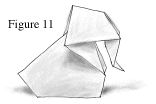
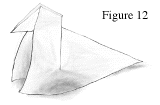
A sheet of paper has a shape before folding, usually square or rectangular. As we fold it, the shape changes. The resulting shape is, so to speak, hidden in the sheet of paper before folding. We can only bring out shapes that are contained in the original paper. But bringing out shapes that are easily seen in the original paper, as when we fold the square in half diagonally and say it is a mountain, arouses little interest because we can envision the image without folding it.
Therefore, we can say good shapes in origami are unexpected shapes. Fording an origami beetle from one sheet of square paper without cutting is marvelous because we cannot see the shape of the beetle in the original square. If we cut a piece of paper into the shape of the beetle and fold it, as in pop-up cards, it cannot be a good origami work, though it may be a good paper-craft.
If we fold something realistic, such as a beetle with six legs and two horns, from one piece of a square paper, we can say the model has a good shape because the shape is unexpected. It is difficult to image the shape of the beetle in the original square. But bringing out an unexpected shape is not sufficient to make a good origami work. We can crumple a sheet of paper, then pinch out the necessary appendages to make a beetle. It is amazing that such shape of the beetle is contained in a square, but few people regard such work as good origami because, according to my conditions, they are not folded in good ways. So what is the good way?
The pieces of paper have shape, thickness, texture, and so on. In making origami we should make the most of, rather than fight against, the nature of paper. If a work requires such acrobatic folds that it is difficult to fold without tearing the paper, or extremely thin and large paper because it is created without taking the thickness of paper into consideration, I will not regard the work as a good example of origami. I think we can say the good way is the faithful way. That is, faithful to the paper as a physical entity.
If we accept that good works of origami are those in which unexpected shapes, which are not evident before folding, are brought out by faithful folds, then how do we incorporate Jackson's one crease origami? I have said that the shapes of his models are not evident before being folded, and that they are indeed origami. In addition, as the folds in the works are very faithful to the paper, and as the shapes of them are very surprising, I feel we can say his works are good origami. The folds are so faithful that the piece of paper sometimes tells us where to fold, and we will be astonished at the final shape.
I must confess, however, I do not think all works of one crease origami are good. The technique of one crease origami does not guarantee a good work. It seems that the general conditions, which I have done in this chapter, are imperfect for the critique of origami works. We must evaluate each work individually. Though our conclusions may differ, we can and should consider why we like a particular work and dislike another.
![[home]](../../../global/ToHome.gif)
![[back]](../../../global/Up.gif)
